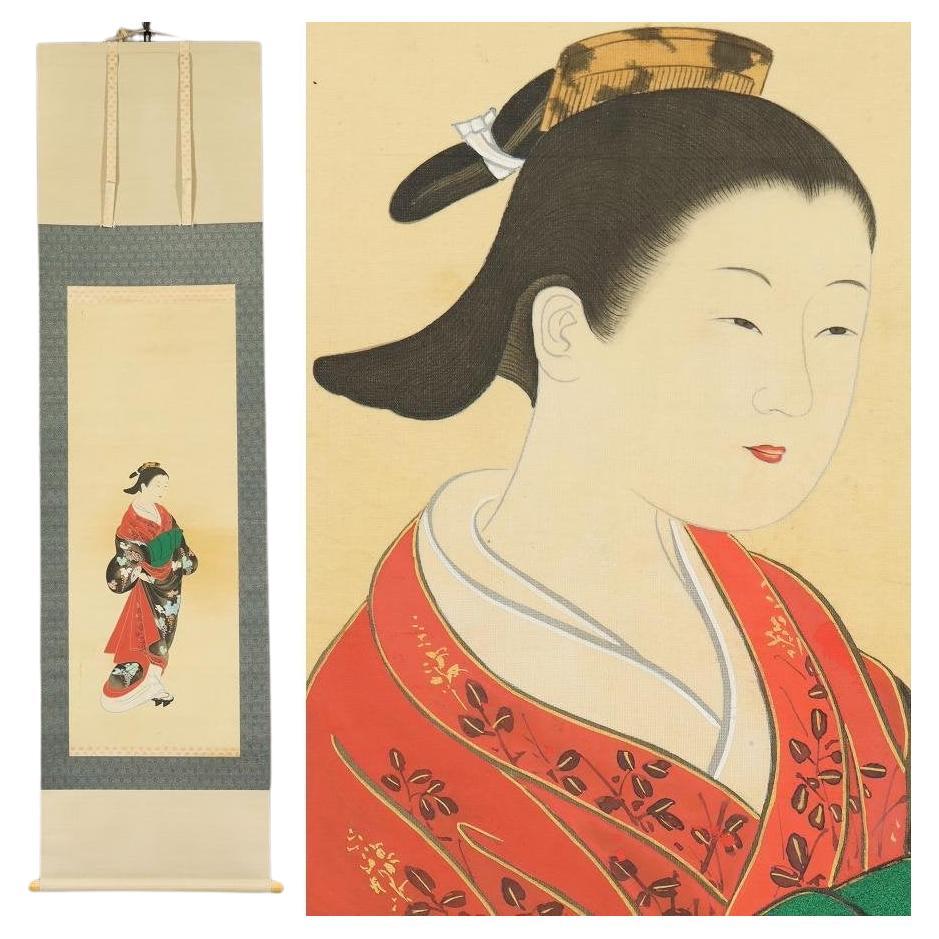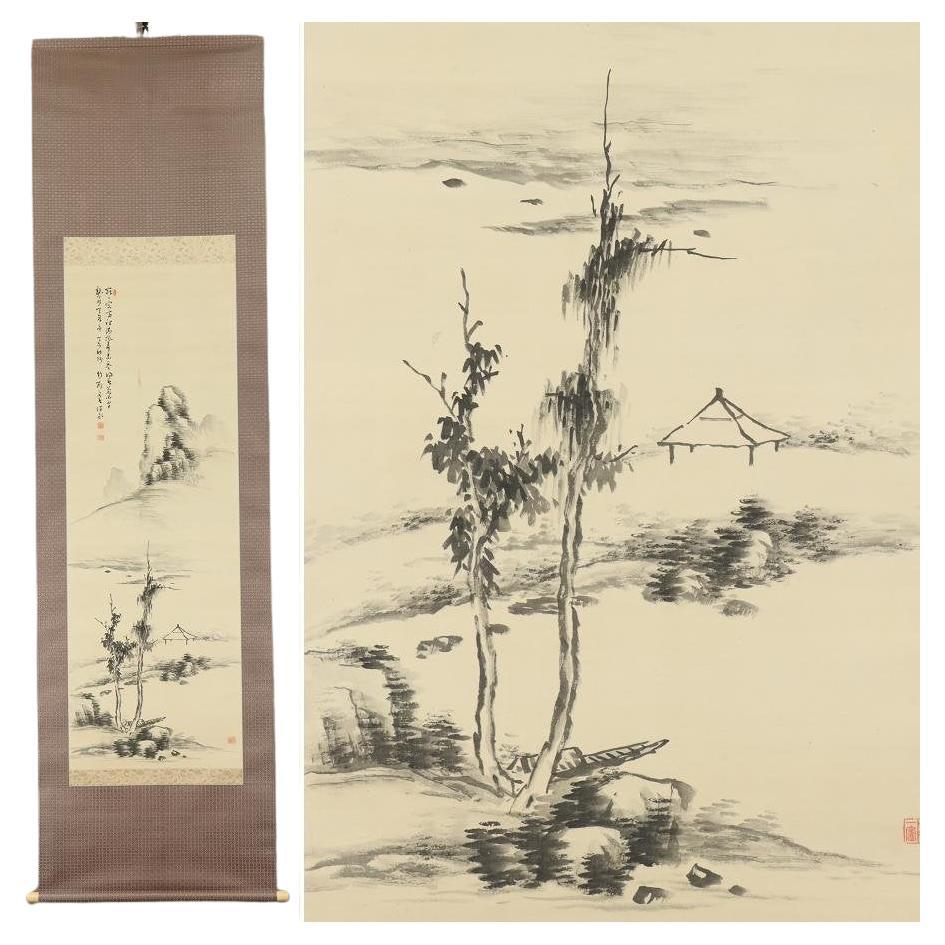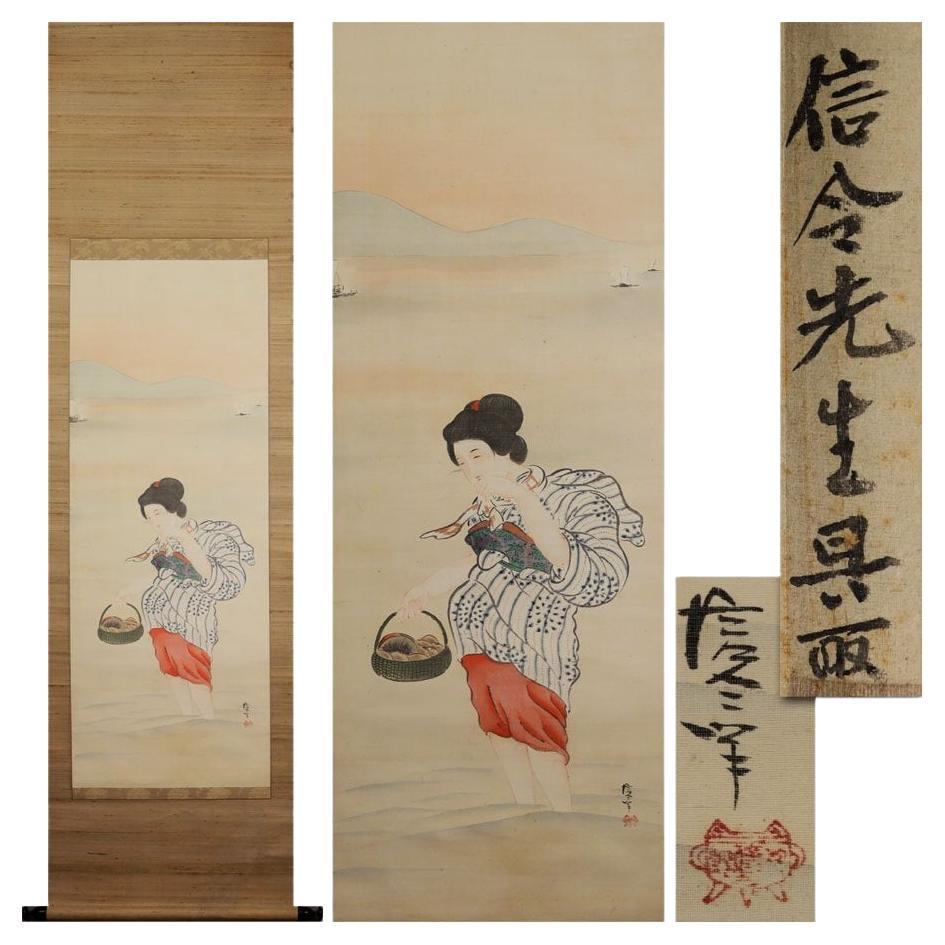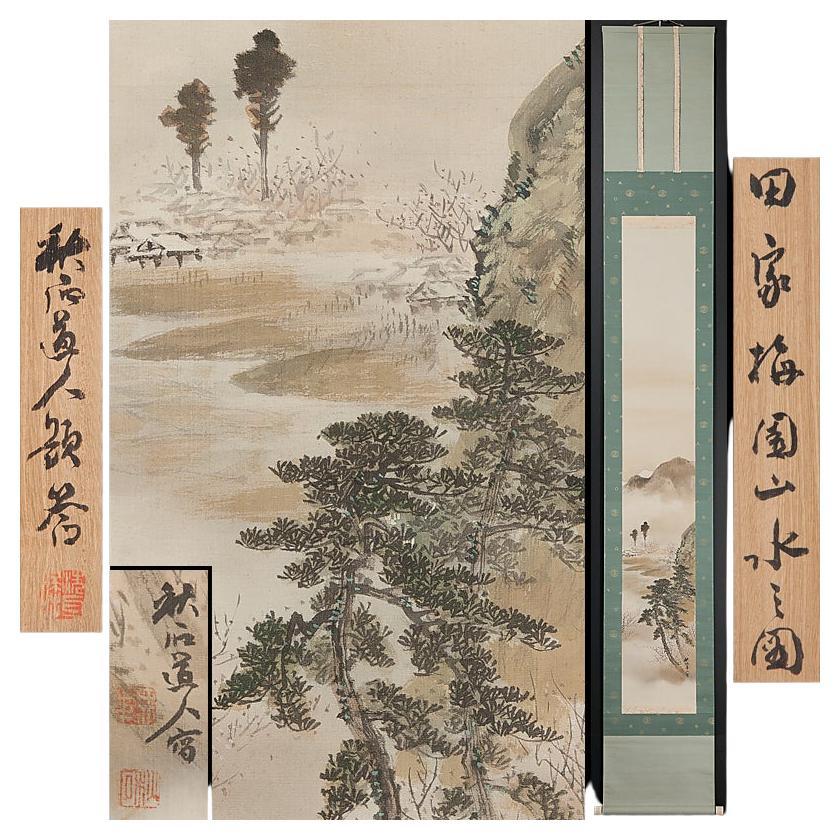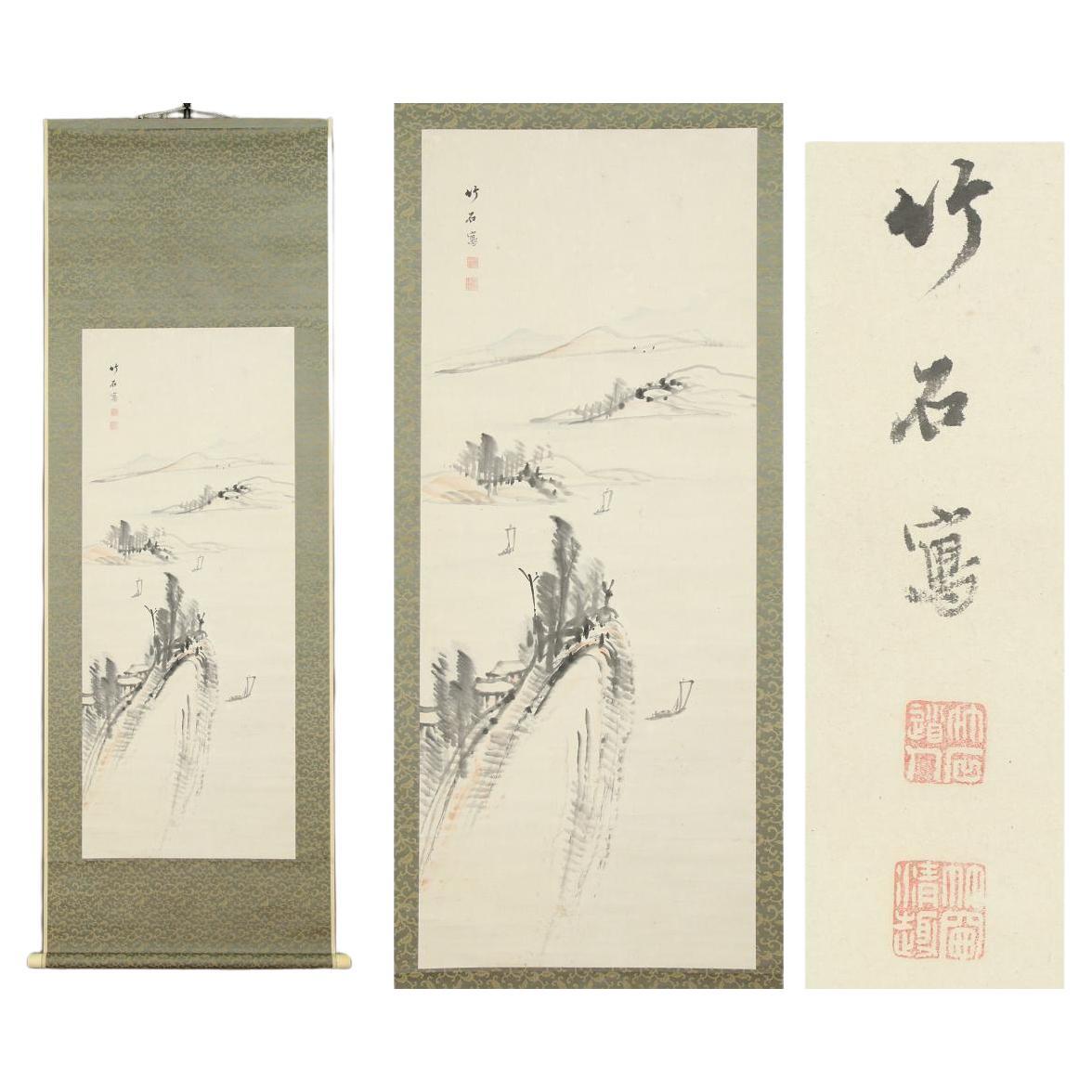Items Similar to Japanese Painting Meiji Scroll Taizo Tae Nihonga New Year's Day, 1903
Want more images or videos?
Request additional images or videos from the seller
1 of 7
Japanese Painting Meiji Scroll Taizo Tae Nihonga New Year's Day, 1903
About the Item
The following is a work depicting a picture of bamboo in the snow, drawn by Sodo Tae (Taizo).
[Tae Sodo]
1870 (Meiji 3) - 1939 (Showa 14)
Agricultural manager, politician, and Japanese painter from the Meiji period to the early Showa period.
Member of the House of Representatives, Chairman of the Tottori Prefectural Assembly, Mayor of Shimohojo Village, Tohaku District, Tottori Prefecture.
His name is Sodo, Sodo, and Soo.
He studied calligraphy and painting under Shibaishi Makino, and reached the level of an expert in landscape painting.In his
later years, he stayed in various places to create paintings and calligraphy.
■Silk book, handpainted
■Condition:
There is discoloration due to the age.
■Dimensions
Axis dimensions: approx. 202.0cm x approx. 52.0cm.
Main paper dimensions: approx. 118.0cm x approx. 36.5cm.
■Inscription
There are inscriptions and inscriptions as shown.
■Box
included.
- Dimensions:Height: 79.53 in (202 cm)Width: 20.48 in (52 cm)Depth: 0.04 in (1 mm)
- Style:Edo (Of the Period)
- Materials and Techniques:
- Period:1900-1909
- Date of Manufacture:1903
- Condition:Wear consistent with age and use.
- Seller Location:Amsterdam, NL
- Reference Number:
About the Seller
5.0
Vetted Seller
These experienced sellers undergo a comprehensive evaluation by our team of in-house experts.
Established in 2015
1stDibs seller since 2019
158 sales on 1stDibs
Typical response time: 7 hours
- ShippingRetrieving quote...Ships From: Amsterdam, Netherlands
- Return PolicyA return for this item may be initiated within 14 days of delivery.
More From This SellerView All
- Japanese Painting Meiji 1903 Scroll Suzuki Shoutoshi Nihonga New Year's Day 1903Located in Amsterdam, Noord HollandProduct Description This is a work drawn by Matsutoshi Suzuki on New Year's Day, 1903, as you can see. The figure of the zodiac ``Snake'' and a jewel are depicted, and a poem of prai...Category
Antique Early 1900s Edo Paintings
MaterialsSilk
- Japanese Nihonga Painting 19th Meiji Scroll Ukiyo-E Beautifull LadyLocated in Amsterdam, Noord Holland◆ Ukiyo-e ◆ Beautiful woman painting ◆ Japanese painting ◆ Hand-painted painting ◆ Silk ◆ Hanging scroll ◆ This work is drawn by hand and on...Category
Antique 19th Century Edo Paintings
MaterialsSilk
- Japanese Nihonga Painting 19th Meiji Scroll Tajika Chikuson Landscape NangaLocated in Amsterdam, Noord Holland[Authentic Artwork] ◆ Chikuson Tajika ◆ Autumn Landscape ◆ Master: Naoiri Tanomura ◆ Oita Prefecture ◆ Hand-Painted ◆ Silk Mounted ◆ Hanging Scroll ◆ Delve into the artistry of Chik...Category
Antique 19th Century Edo Paintings
MaterialsSilk
- Japanese Nihonga Painting 19th Meiji Scroll Ukiyo-E Lady picking ClamsLocated in Amsterdam, Noord HollandProduct Description This piece depicts a beautiful woman with her skirts rolled up as she hunts for clams on a shallow shore , giving it an indescribably impressive expression....Category
Antique 19th Century Edo Paintings
MaterialsSilk
- Japanese Nihonga Painting 1900 Meiji/Taisho Scroll Shûseki, Okutani LandscapeLocated in Amsterdam, Noord HollandSusheki Okutani "Takaya Plum Garden Landscape" Silk, Colored, Authentic, Hanging Scroll, , Double Box size Axis: Height 206.5cm Width 29.3cm Drawing…Height 126.7cm Width 19.5cm *There may be slight differences in dimensions. Thank you for your understanding. situation It is in good condition, but please note that there are some light stains. Please check the image for details. Thank you for your support. Biography Akishi Okutani Japanese painter. Born in Osaka. His name is Tsunejiro. He studied under Kansai Mori. From an early age, he exhibited his works at the Japan Painting Association and the Young People's Painting Association, which was led by Gaho Hashimoto and Gyokusho Kawabata, and won numerous awards. He also opened a private school...Category
20th Century Taisho Paintings
MaterialsSilk
- Japanese Painting 18c Edo Scroll Chikuseki Nagamachi Nihonga Landscape PaintingLocated in Amsterdam, Noord Holland[Authentic Artwork] ◆ Nagamachi Chikuseki ◆ Landscape ◆ Edo Period ◆ Mitsuishi Origin ◆ Kagawa Prefecture ◆ Handwritten ◆ Paperback ◆ Hanging Scroll ◆ k891 ◆ Nagamachi Chikuseki Explore the artistry of Chikuseki Nagamachi...Category
Antique 18th Century Edo Paintings
MaterialsSilk
You May Also Like
- Japanese Meiji Riverside Scroll Painting, c. 1900Located in Chicago, ILAlthough western painting was initially embraced during Japan’s Meiji period (1868-1912), artists brought on a revival of traditional painting styles as they sought to create a modern Japanese style with roots in the past. This exquisite hanging scroll demonstrates the preference for soft layering of gray tones with judicious use of color. The landscape is rendered in soft ink washes that subtly distinguish between water, mountain, and sky. The scroll painting...Category
Early 20th Century Japanese Meiji Paintings and Screens
MaterialsPaper
- Antique hanging scroll of Japanese cat/Late Edo-Meiji period/Cat paintingLocated in Sammu-shi, ChibaThis is a picture of a cat drawn by a person named "Toshizumi Nitta" from the end of the Edo period to the beginning of the Meiji period. She is a very simple and cute cat. He is a vassal of the Tokugawa Shogunate, born in Ota City, Gunma Prefecture (southern part of Gunma Prefecture). He was related to the Tokugawa family and lived in a large mansion in the Ota clan in Gunma prefecture. However, the Nitta family's territory was very small, and they were by no means a wealthy vassal. He seems to have lived quite poorly. So he painted cats and sold them to people. The Nitta family continued to draw pictures of this cat for four generations. "Nitta toshizumi" is equivalent to the fourth generation. During the Edo period, sericulture was thriving in the Kanto region. Cats were said to be the gods of silkworms, as they drive away mice, the natural enemies of silkworms. It was the Nitta family who drew such a cat on paper, pasted it in the silkworm chamber, and sold it as a mouse repellent. There were also other monks who painted pictures of cats, but the Nitta family in particular was related to the Tokugawa family, so people believed that paintings of cats had special powers. , a lot of paintings...Category
Antique Late 19th Century Japanese Edo Paintings
MaterialsPaper
- 1844 - Chichi, Japanese Scroll Painting. Colour on SilkLocated in Kyoto, JPMother’s Breast (Chichi) 1844 Hanging scroll. Ink, pigments and gofun on silk. Inscription: Kouka era, dragon year, late winter, painted by Shozan Yashou Artist’ seals: ...Category
Antique 1840s Japanese Edo Paintings and Screens
MaterialsSilk
- 260 Year Old Japanese Hanging Scroll with Painting of the 9-Headed Dragon DeityLocated in Amsterdam, NLAmazing 260 year old Japanese kakejiku (hanging scroll) with a refined painting of the nine headed dragon deity, with a Buddhist flame as a crown, an...Category
Antique Mid-18th Century Japanese Paintings and Screens
MaterialsMetal
- Chinese New Year Painting, c. 1900Located in Chicago, ILIn celebration of the lunar New Year festival, it was traditional all over China to hang special decorations. In a city called Wuqiang, local artists made lacquer scroll paintings laden with symbolism. This framed and finely rendered early 20th century folk painting from Wuqiang features an imperial court official and his family dressed in their best silks. The young boy is dressed in a wonderfully patterned yellow robe to offer Shou Xing...Category
Early 20th Century Chinese Qing Paintings and Screens
MaterialsPaper
- Japanese Painting, Hanging Scroll, 19th Century Bamboo in MoonlightLocated in Kyoto, JPBamboo in moonlight Gamo Rakan (1784-1866) Hanging scroll, ink on silk. Dimensions: Scroll: 201 cm x 58 cm Image: 137 cm x 45 cm In this early 19th century work by Gamo Rakan a light ink wash applied to the silk background silhouettes the moon and suggests the atmosphere of early evening. Even though it is a literati subject, Rakan’s bamboo is quite realistic with a strong decorative style. The painting finds its inspiration from Chinese Ming dynasty painters who often used a single-tone, jet black stroke to emphasize the calligraphic nature of bamboo. In a different era, decorative would have been seen as somewhat unrefined. But increasingly in the Edo period, it was the hallmark of high style. The Japanese people, in particular the rising merchant class, had gradually become apathetic toward the traditional Sesshu and Kano schools of painting. Chinese professional and amateur painters living in the port of Nagasaki during the 18th century had a profound effect on Japanese painting and the freshness of their style and its decorative appeal contributed greatly to its popularity. Gamo Rakan’s teacher, Tani Buncho...Category
Antique Early 19th Century Japanese Edo Paintings and Screens
MaterialsSilk
Recently Viewed
View AllMore Ways To Browse
Japanese Paper Scroll
Japanese Scrolls Painting
Scroll Painting Silk
Meiji Silk
Edo Period Paintings
Japanese Silk Painting Scroll
Meiji Period Scrolls
Antique Japanese Scroll Painting
Nihonga Paintings
Calligraphy Scroll
Japanese Scroll Box
Japanese Bamboo Paintings
Japanese Silk Painting Edo
Japanese Scroll Edo
Edo Scroll
Japanese Landscape Scroll
Antique Bamboo Box
Edo Period Scroll

